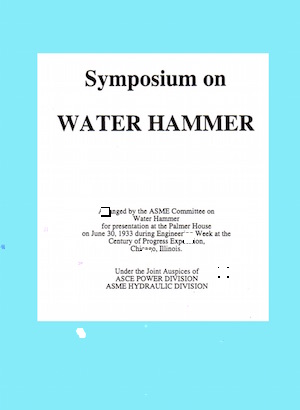Water Hammer as a Power Source "The collapse of the smaller vapor filled cavities causes many extreme results as the intensity of the resulting shock wave may be considerably greater than the originating action. As an analogy with an explosion, the initiation of the cavities is the trigger action while their collapse is the explosion." (1)
"It has been shown that rectification of the gas diffusion occurs because the surface area of the bubble varies during the sound pressure cycle. During the positive half-cycle the solution is undersaturated and gas diffuses out of the bubble; during the negative half-cycle it is supersaturated and gas flows in. But the surface area is larger during the negative half than during the positive half-cycle, so that there is an excess influx. If the rate of sonically induced diffusion into the bubble exceeds the rate which the gas diffuses because of the excess pressure resulting from the surface tension, the bubble grows in size." (2)
"Cavitation in a tube can be explained according to Bernoulli's equation:
It is found that the sum of pressure and kinetic energy in a flowing liquid is constant. Thus the velocity of a liquid passing through a restriction may become so high that the hydrodynamical pressure is reducted to the vapor tension." (3)
"Lord Raleigh in 1917, calculated the pressure developed during the collapse of a spherical cavity.
P pressure at infinity external atmospheric pressure R0 initial radius of the cavity b the coefficient of compressiblity P' and R correlated pressure and radius of the cavity during the collapse
Calculation of the above equation shows that pressure of thousands of atmospheres may be developed at the moment when the cavity collapses to a small fraction of the original diameter. Such collapses are, therefore, bound to cause enormous mechanical effects, as high kinetic energies are being concentrated at very small spots." (4)
(1) Crawford, Alan E.,Ultrasonic Engineering with particular reference to high power applications; Butterworths Scientific Publications, 1955, London. page 26. (2) Crawford, Alan E.,Ultrasonic Engineering with particular reference to high power applications; Butterworths Scientific Publications, 1955, London. page 30. (3) Prakash, Satya and Ghosh, Ashim Kumar; Ultrasonics and Colloids; Scientific Research Committee, Allahabad, India, 1961. page 114 (4) Prakash, Satya and Ghosh, Ashim Kumar; Ultrasonics and Colloids; Scientific Research Committee, Allahabad, India, 1961. page 115

See Also
Cavitation Etheric Vapor Implosion Part 15 - Dissociating Water Sonofusion Sonoluminescence 15.02 - Liberating Ozone from Water 15.04 - Dissociating Water with Fire 15.06 - Power of Dissociated Water 15.08 - Dissociating Water with X-Rays - Radiolysis 15.09 - Dissociating Water with Ultrasonic Vibration - Puharich 15.10 - Dissociating Water with Alternating Current - Puharich 15.11 - Dissociating Water with Vacuum 15.12 - Dissociating Water with Acoustic Cavitation 15.13 - Dissociating Water Acoustically - Liberation of Quantum Constituents 15.18 - Keelys Process for Liberating Ether from Water 15.21 - Water Dissociation Demonstration 15.22 - Water is Sensitive to Thought 15.23 - Water is Predominantly Diamagnetic 15.24 - Water is Sensitive to Biometeorological Effects
